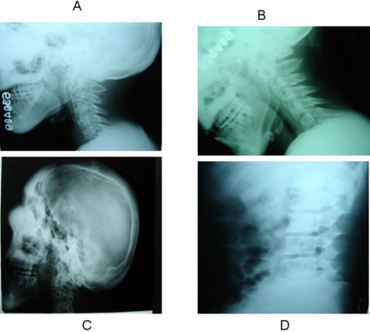Polyostotic fibrous dysplasia
Jump to navigation
Jump to search
| Polyostotic fibrous dysplasia | |
|---|---|
| Other names: Albright's disease[1]: 578 | |
 | |
| Leontiasis ossea and cervical cord contusion as rare complications of Polyostotic fibrous dysplasia- a,b)Hypertrophy of posterior elements c)diffuse cortical thickening on lateral skull d) diffuse thickening of lumbar vertebrae. | |
| Specialty | Osteology |
Polyostotic fibrous dysplasia is a form of fibrous dysplasia affecting more than one bone.[2] Fibrous dysplasia is a disorder where bone is replaced by fibrous tissue, leading to weak bones, uneven growth, and deformity. [3]
McCune-Albright syndrome includes polyostotic fibrous dysplasia as part of its presentation.[4] When polyostotic fibrous dysplasia manifests in the long bones, limping results; when it manifests in the face, asymmetric growth of the face can result.[3]
One treatment that has been used is bisphosphonates.[5]
See also
- Fibrous dysplasia of bone
- Monostotic fibrous dysplasia
- List of radiographic findings associated with cutaneous conditions
References
- ↑ James, William; Berger, Timothy; Elston, Dirk (2005). Andrews' Diseases of the Skin: Clinical Dermatology. (10th ed.). Saunders. ISBN 0-7216-2921-0.
- ↑ "Fibrous Dysplasia: Overview - eMedicine Radiology". Archived from the original on 2012-07-05. Retrieved 2009-02-23.
- ↑ 3.0 3.1 Reference, Genetics Home. "McCune-Albright syndrome". Genetics Home Reference. Archived from the original on 2018-01-07. Retrieved 2018-10-30.
- ↑ Lee, Peter A. (5 December 1986). "McCune-Albright Syndrome: Long-term Follow-up". JAMA: The Journal of the American Medical Association. 256 (21): 2980–4. doi:10.1001/jama.1986.03380210076028. PMID 3773215.
- ↑ Khadilkar VV, Khadilkar AV, Maskati GB (September 2003). "Oral bisphosphonates in polyostotic fibrous dysplasia". Indian Pediatr. 40 (9): 894–6. PMID 14530553. Archived from the original on 2018-03-23. Retrieved 2021-06-26.
External links
| Classification | |
|---|---|
| External resources |